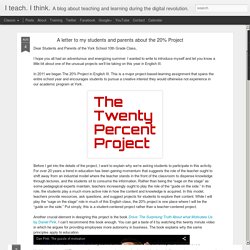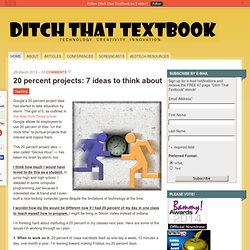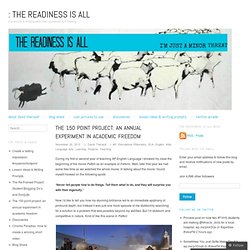

Plan sheet. 20% Project. Inspire Drive, Creativity and Innovation in the Classroom with the 20% Project Daniel Pink asks us to find what drives us.

Sir Ken Robinson asks us to inspire creativity in students. The latest in education is asking us to find essential questions for students. How? One way is to institute a 20% project in class. The Why: 3M started it in the 1950’s with their 15% project. Several educators today are extending the ideas of the 20% into their own classrooms with the hope that the project fosters creativity, innovation, and intrinsic motivation. The What: In education the 20% project is a little different for each teacher. The How: I introduce the project in the Explore-Flip/Expain/Apply method. You may work alone or with a small group.Decide carefully. The When: I introduce this project in the first week of school and let them know their proposal presentations* are due 5 weeks later (mid-October).
The Who: My students are 12th grade college-prep level students. Assessment: * Resources: The Launch. A letter to my students and parents about the 20% Project. If new technology doesn't simplify your life, change it or dump it.

A little over a year ago our school switched from Moodle to Haiku for our LMS program. I'm really happy with Haiku, and I think many of our teachers are seeing the benefits. The assessments and gradebooks have saved me a lot of time, and I love how well they're all integrated. However, Haiku has one fatal flaw. It's slow. When I am building an assessment or managing my grades, I don't mind the time it takes for Haiku to authenticate me. Last year at Fall CUE, I attended Lisa Highfill's workshop on flipping the classroom. 20 percent projects.
Google’s 20 percent project idea has started to take education by storm.

The gist of it, as outlined in this New York Times article: Google allows its employees to use 20 percent of their “on the clock time” to pursue projects that interest and inspire them. This 20 percent project idea — also called “Genius Hour” — has taken my brain by storm, too. I think how much I would have loved to do this as a student.
In junior high and high school, I dabbled in some computer programming just because it interested me. A friend and I even built a nice-looking computer game despite the limitations of technology at the time. I wonder how my life would be different now if I had 20 percent of my day in one class to teach myself how to program. I’m thinking hard about instituting a 20 percent in my classes next year. 1. 2. [RELATED: 20 percent projects: 10 must-have tools] The 150 point project. During my first or second year of teaching AP English Language I showed my class the beginning of the movie Patton as an example of rhetoric.

Well, later that year we had some free time so we watched the whole movie. In talking about the movie I found myself hooked on the following quote: “Never tell people how to do things. Tell them what to do, and they will surprise you with their ingenuity.” Now I’d like to tell you how my stunning brilliance led to an immediate epiphany of profound depth, but instead it was just one more episode of me stubbornly searching for a solution to a problem that was possibly beyond my abilities.
See I was never a great student in high school and by great student I mean I never wanted to do what I was told. The first was a research paper on violence in America. Then there was my attempt at some much needed extra credit. I will never forget these assignments because they were mine. I began to do this whenever I could.
“Hi everyone. And that’s it. Yleisarviointi. Itsearviointi. Audience Centered Learning.